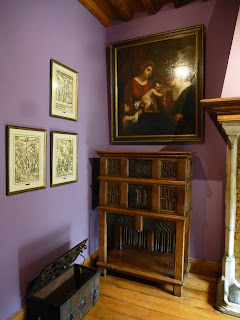Vilvoorde, a town of some 40,000 people north-east of Brussels, has several claims to fame.
As a postcard for post-industrial decay.
When in 1931 Renault located its first auto assembly plant in this municipality, it promised jobs and plenty of them for workers and suppliers. The unexpected announcement by the company's chief executive officer of the closure of manufacuring in 1997 brought the dream to a crashing halt. 3,000 workers lost their jobs, as did 1,500 employees in direct supply firms. Although, the Paris stock market reacted with glee, elevating Renault's stocks by 13% in a single day, Vilvoorde went through a massive tailspin from which it has not recovered.
As a place where Protestants cherish their martyrs.
 An Englishman, William Tyndale, Oxford scholar and Bible translator was strangled here and burnt at the stake in 1536.
An Englishman, William Tyndale, Oxford scholar and Bible translator was strangled here and burnt at the stake in 1536.
In 1596, Anna Utenhoven, an Anabaptist, was buried alive for heresy - the last such victim in the territory of today's Belgium.
As an execution ground for opponents to the Spanish Crown.
In the 16th century, the powerful and feared Duke of Alba, Fernando Álvarez de Toledo, Governor of the Spanish Netherlands, one of the most brilliant generals ever, had two nobles executed here for treason. Lord Anthony van Stralen, a mayor of Antwerp, and Lord Jan van Casembroot, a governor of Oudenaarde, were beheaded in 1568. These actions contributed to the black legend of the so-called Spanish Fury.
As "the n°1 provider of Belgian jihadis," so says POLITICO. And "which at one time boasted the highest per capita rate of Western foreign fighters in Syria," that's according to the New York Review of Books.
And as the site of what is considered the oldest - 800-years-old - Carmel in Western Europe.
None of these reasons endear Vilvoorde to visitors.
However, I do hope the photos of the Carmelite monastery do convey the tranquil beauty of this gem.
It is worth visiting, at least as a short respite from the hustle and bustle of the town, if not for a longer contemplation of the immutability of certain aspects of our universum.
The church of Our Lady of Consolation (Onze-Lieve-Vrouw ten Troost), holding a miraculous statue of the Virgin, has for centuries been a place of pilgrimage.
For this reason it has been raised to the status of a basilica.
The church's baroque interior is snow-pure white, sparsely, but beautifully adorned with the prominent markings of the Carmelite tradition.
 |
| Mary and Jesus, with the scapular. Also the Discalded Carmelite emblem. |




















































